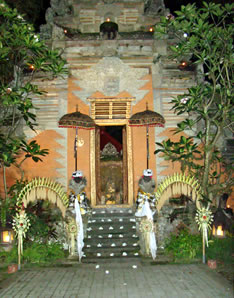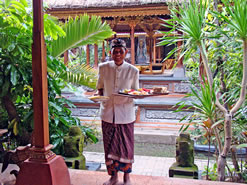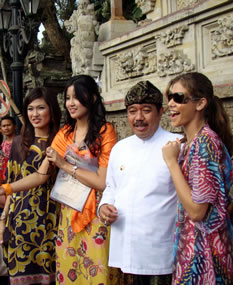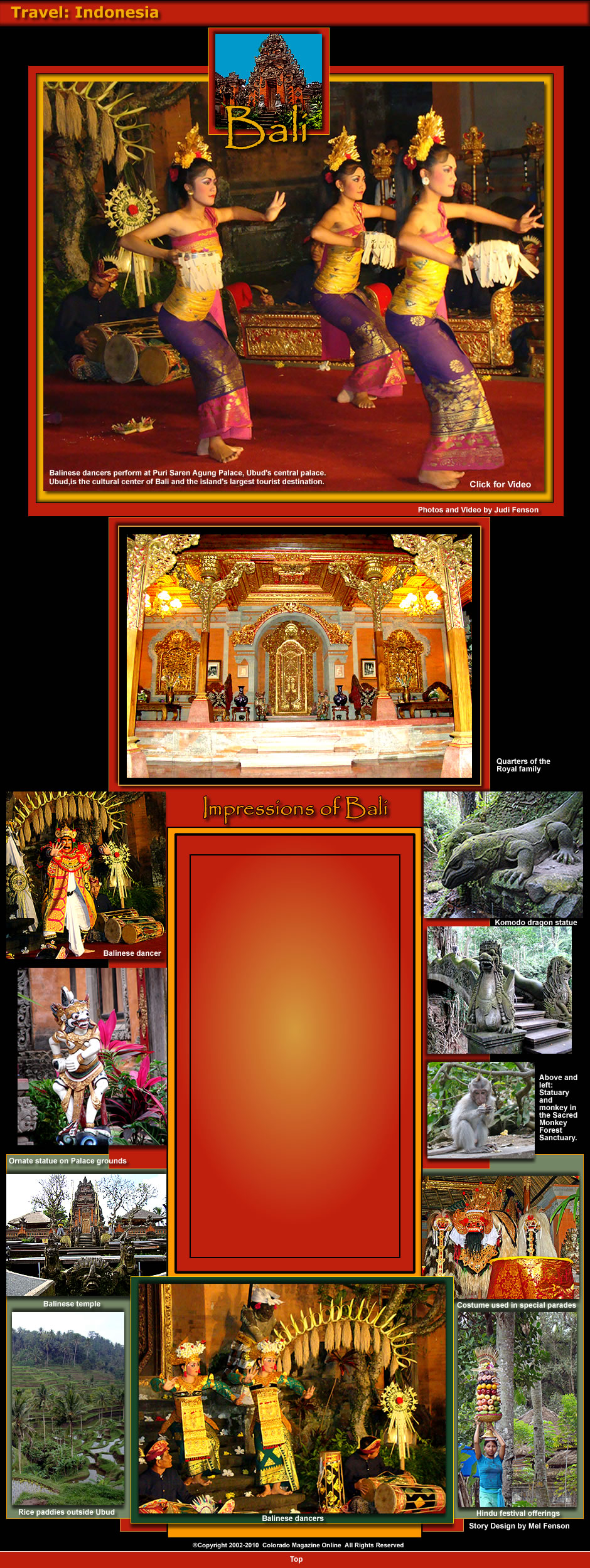by Larry and Judi Fenson
A
quiz
for the reader: Can you name the country that includes these provinces:
Kalimantan, Nusa Tenggara? Need more? How about: Sulawesi, Aceh. Is that enough?
No? Well OK, What about: Maluka, Lombok, Sumatra? Haven't figured it out yet?
OK, then here's some dead giveaways: Java, West Papua. If that's still not
sufficient, here's the corker: Bali.
That's right! It's Indonesia, a country little known by most Americans. In August 2008, we traveled to West Papua, the easternmost region of Indonesia, a place where one can visit indigenous tribes in villages little changed in the last century.
Reaching West Papua required a stopover on our outbound route in Bali so we decided to spend a few days there.
A
little information about Indonesia
Perhaps the first association most Americans have for Indonesia is highly
negative -- the 2002 and 2005 bombings in Bali (in the beach town of Kuta)
that killed more than three hundred tourists and locals. To be honest, we
also knew very little about the country. And our current knowledge after our
18 day trip is of course still quite limited. The fact is, Indonesia is a
vast country of great environmental and cultural diversity, stretching across
more than 17,000 islands. One would have to travel extensively just to begin
to sample the main regions. But here's what we have learned from our travels
and a little reading.
Indonesia is the world's 4th most populous country at 237 million. It seems odd, doesn't it, that we know so little about such a large country. In part, that's probably because it is a collection of over 17,000 islands that were only given their independence as a unified country by the Netherlands in 1949. And Indonesia hasn't exactly been a central player on the world scene since that point.
The five
main islands are Kalimantan, Sumatra, West Papua, Sulawesi, and Java.
Kalimantan, which occupies two-thirds of the island of Borneo, is the largest
Indonesian island, about a third larger than California. The table shows the
size and population of each of the five main islands relative to California
which has a population of about 37 million and covers an area of 158,706 square
miles.
INDONESIAN
PROVINCE SIZE IN SQUARE MILES POPULATION SIZE RELATIVE TO CALIFORNIA
Kalimantan 208,285 9 million 32 % larger than California
Sumatra 182,859 45 million 15% larger than California
West Papua 162,926 2.7 million 2% larger than California
Sulawesi 74,056 16 million About half the size of California
Java 51,006 130 million About one third as large as California
Bali 2,174 3.2 million About 1/100th the size of California
Java and Bali are extensively planted with rice fields. Kalimantan, West Papua, Sumatra and most other regions are blanketed with tropical rain forests. Most of Indonesia is tropical, with lots of rain and high humidity. Indonesia lies in the "Ring of Fire" which contains the majority of the world's volcanoes. Indonesia claims some 400 volcanoes, about 100 of which are active, the highest total of any country. Frequent earthquakes are one of the consequences. The highest peak in Indonesia (16,019 feet) is in West Papua. Peaks topping 9,000 ft. are found on most of the other large islands. One of the most distinctive things about Indonesia is the diversity of its peoples - some 300 different ethnic groups. Jakarta, Indonesia's largest city is the world's 11th largest with a population of 8.4 million and the word's 7th largest urban area at 17.3 million.
Getting
to Bali
We had arranged to stay in Ubud, the cultural center of Bali and the island's
largest tourist destination. Ubud is about a one hour taxi ride north from
the airport. In contrast to most of Indonesia, Bali's population is over 90%
Hindu and you see Hindu temples everywhere.
The Palace
The most common form of lodging in Ubud is the home stay. These are small,
family run establishments that are extremely economical, typically 5 to 7
dollars per person per day. We were planning on a home stay until Judi discovered
that it might be possible to book lodging in Ubud's central palace -Puri Saren
Agung. It sounded interesting but she could find little additional information.
Our West Papua tour agent referred Judi to his contact person in Bali and
she was indeed able to make reservations for us. Our taxi delivered us at
the front gate of the palace and we walked through the ornate gates, feeling
a little odd rolling our bags along behind us, wondering if this whole thing
was a misunderstanding. But we were met by the kindly manager (Putu) who warmly
greeted us and led us through the palace grounds to our quarters, two individual
units, separated by a walkway. The accommodations were comfortable though
not fancy. What left us wide-eyed, however, were the exteriors and the verandas.
Each was lavishly trimmed in gold gilt and decorated with sculptures, gargoyles,
elaborate wooden carvings and exquisite porcelain pottery. The verandas were
furnished with brocaded settees, couches, chairs and ornate tables. Think
of the setting in the movie "The King and I."

Palace Grounds
Positioned around the adjoining grounds were arched gates, massive doors, sculptures and fountains. It looked like, well, a royal palace. Across the courtyard was the prince's residence. Scattered about were other units that other members of the family used when in residence. Some are rented to travelers at other times.
Each morning we were served an elaborate breakfast on our veranda by a diminutive, polite, elderly man whose sole job was to take care of the two units that we and our friends were in and to serve our breakfast. He walks to the palace each morning from his village which is about a mile away. Breakfast was delicious, always featuring several local dishes new to us.

On our last day at the palace, there was considerable excitement when the
prince arrived Accompanying the prince was Miss Universe who happened to be
a Balinese citizen.

Balinese Prince and Miss Universe.
Ubud
Ubud is like an overgrown village set down in a tropical forest with narrow,
winding streets and exotic vegetation everywhere. People love Ubud and it
is easy to see why. It is friendly, manageable, exotic, beautiful and affordable.
Situated about 1000 feet above sea level, it has the advantage of being cooler
and less humid than the coastal regions.
Wherever we were in the town, about every 15 minutes, a Hindu festival procession
would pass by, comprised of a number of teens and pre-teens (all male) carrying
banners and playing drums and other instruments.
Ubud's streets are lined with home stays, cafes and shops. Judi found a tailor
along one of these streets and had two outfits custom made. Ubud also has
some dramatic places to dine. Several are perched on the slope of a canyon.
The Lotus Restaurant, just one block from the palace, has an especially impressive
setting, positioned in front of a large reflecting pool filled with water
lilies. Sitting on the far side of the pool is large Hindu temple. A stage
and small grandstand is set up in front of the temple, providing a dramatic
backdrop for the Balinese dance performances that take place there most nights.
Excursions from Ubud
The palace has a driver and we made arrangements with Putu for several excursions.
The first was an evening visit to Putu's village, about 30 minutes away, where
a local Hindu festival was being held. En route, we stopped at our driver's
home so his wife could ensure that we were properly attired with sarongs (and
flowers for the ladies' hair). We were the only foreigners present and were
warmly received.
We also made arrangements for a full day tour of the region. Our number one
objective was to see the iconic terraced rice fields for which Bali is so
deservedly famous. We also expressed an interest in seeing some typical villages.
At Putu's suggestion we added a trip to the largest volcano in the region.
En route, we stopped again at Putu's village. This time, we were able to see
another iconic Balinese scene -- women carrying the colorful offerings of
fruit and flowers from their homes to the temple.
Each of the villages we drove through was festooned with festival decorations.
The streets were lined with 20 ft. high poles decorated with intricate arrangements
of bamboo and straw. Temples are everywhere and many homes have their own
private temples which are often as large or larger than the adjacent homes.
Their pagoda-like architecture is dramatic and ornate (like the palace), making
entire villages appear a bit like fairylands.
Bali's terraced rice fields comprise one of its most iconic images, painting
the sculpted hillsides in vivid shades of green. We stopped to admire several
of these spectacular vistas and these stops were indeed high on the list of
our Bali highlights.
Balinese Dance
Bali is also renowned for its highly distinctive form of dancing which has
its roots in the fundamental tenants of Hinduism. Movements of the eyes, mouth,
hands, shoulders, hips and feet are sharp and highly exaggerated yet delicate.
Costumes are extremely elaborate. The elaborately- dressed dancer's staccato
movement accompanied by the unusual sounds of the distinctive gamelan produces
a dramatic and memorable overall effect (which can become overly repetitive
for those who do not appreciate the many subtleties of this art form). Ubud's
premier nightly dance performance takes place at the palace. We specified
the night we wanted to attend. Putu advised us to arrive early and saved some
prime seats for us.
Dance instruction begins at a very young age for those interested. One morning,
on the palace grounds, we witnessed an interesting Balinese dance instructional
session with a group of girls, some as young as 4 or 5 years.
Cost of travel to Bali
Bali is a relatively inexpensive country for Americans. As mentioned, home
stays are usually under $10 per person per night. The Ubud palace where we
stayed was $63 per night including a large breakfast. The one hour taxi ride
from the Denpasar airport to Ubud was about $22. Many agencies offer all day
private car hires with driver for $35. A ticket to the premier dance performance
was $8. Judi's custom-tailored dresses were about $35 each.

